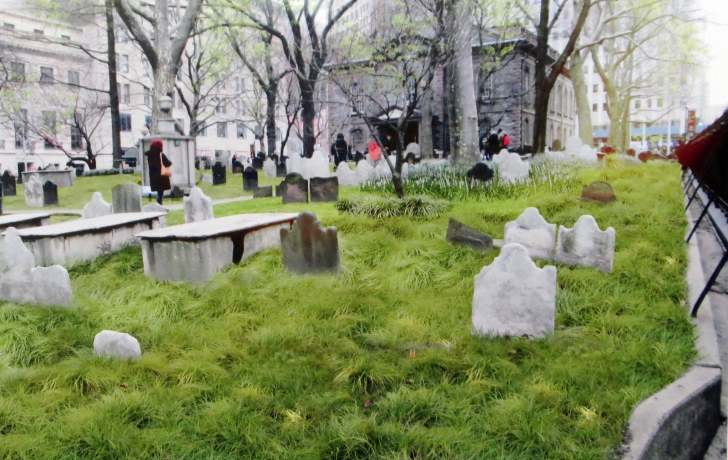By Carl Glassman Tribeca Trib

Today. The sloping southern edge of the cemetery is now subject to erosion. Photo: Mathews Nielsen Landscape Architects
The graveyard at St. Paul’s Chapel is looking kind of dead.
Between the loss of nearly a foot of topsoil in the post-9/11 clean-up and a surge in visitors who now tour the grounds by the thousands, the 300-year-old cemetery is a victim of heavy erosion. Shade from surrounding buildings, including the World Trade Center towers across Church Street, has added to the problem.
Now church leaders have plans to both spruce up the historic site and halt the wear to its grounds. Part of that plan includes changes to the graveyard walkways that would help keep visitors’ feet off the grass—though people are free to walk on the grass if they like. On Tuesday, those proposed changes went before the Landmarks Preservation Commission. The lack of a quorum prevented the commissioners from voting, but their approval appeared certain.
“It’s desperately needed. I was there recently and it’s a wreck,” said Commissioner Elizabeth Ryan. “So it seems what you’re proposing is very sensitive, very minimal and I can support it.”
The walkways, especially in certain areas, are too narrow for the foot traffic, according to Signe Nielsen of Mathews Nielsen Landscape Architects, the firm hired to overhaul the churchyard, located on Church Street between Vesey and Fulton streets.
“If somebody is stopping to read a headstone, others are almost forced to walk off the path because there simply isn’t room to pass,” Nielsen told Community Board 1’s Landmarks Committee earlier this month. “We want to cover critical areas where people stand.”
In two intersections in the path on the yard’s western end, where visitors tend to gather to view the World Trade Center site, the paving would be widened with bluestone. At the western end of the church building, more than 1,000 square feet of brownstone would be replaced.
Along with the new pavement will be new plantings. No new trees will be added to the 28 that are there, but because shade prevents grass from growing beneath the trees, each one will be encircled at its base with evergreen and flowering ground cover. Irrigation had been a problem because the spray was eroding the headstones. A new system will be installed, with spray heads placed along the walkways.
Areas along the shaded and steeply sloping edge of the yard will be covered with a hearty, grass-like plant called carex.
All the plantings would be low, Nielsen said. “The gravestones will continue to read as the dominant element in the landscape.”
Church leaders are not trying to replicate a particular look in the graveyard’s long history, Nielsen noted. Instead, they want to create something that is “contemporary and harmonious with what exists there.”
“The graveyard has evolved so much over the years,” she said. “They feel it should continue to evolve.”

